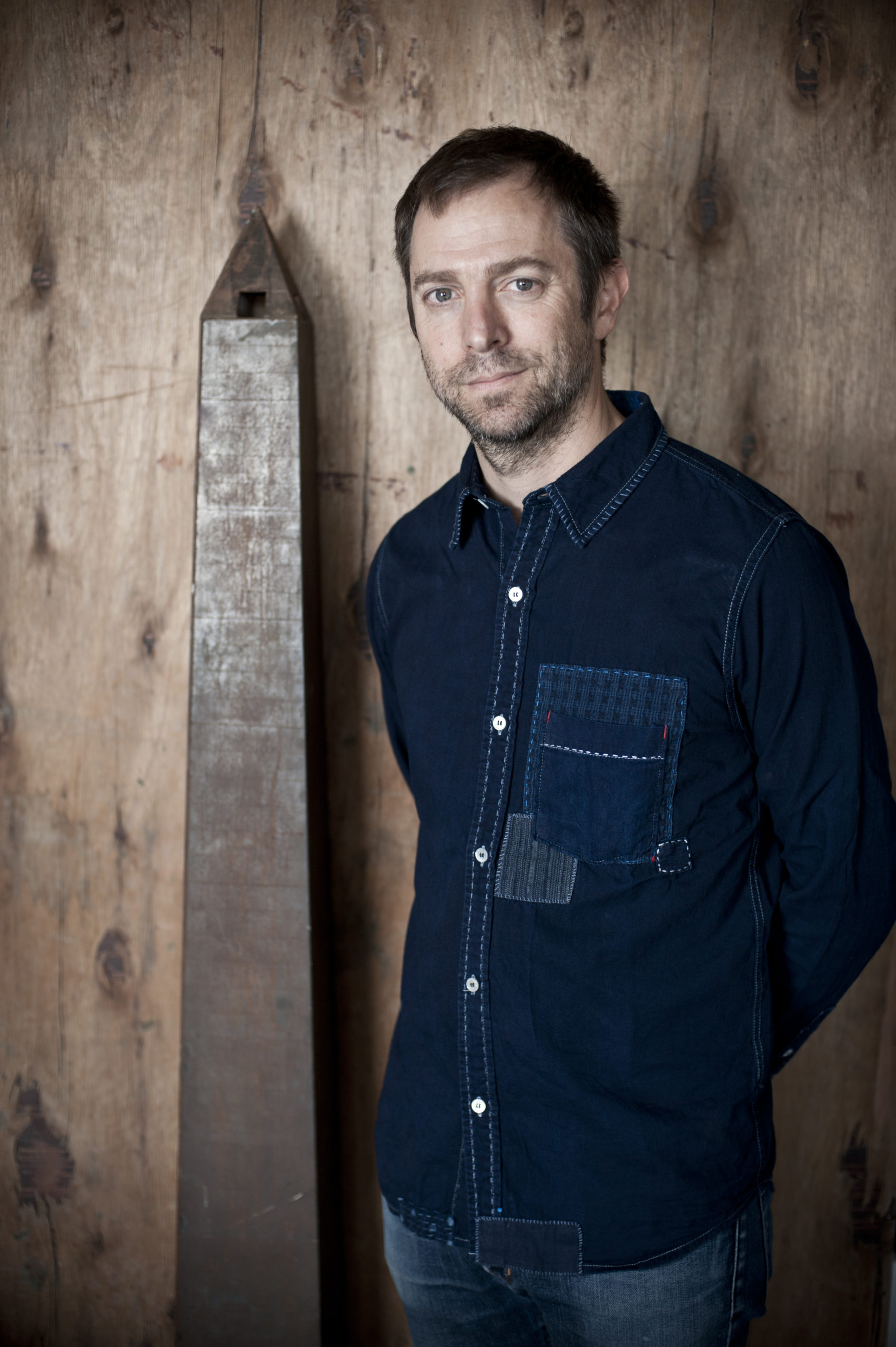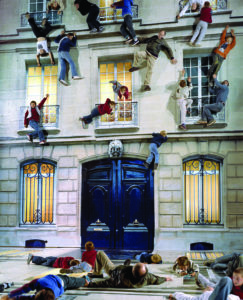Argentinean Wonder Has Art Lovers Climbing Up the Walls at MFAH — When Seeing Is Not Believing
Powerful Art That Keeps Everyone Guessing
BY Leslie Loddeke // 07.19.22Leandro Erlich's “Bâtiment” (Facade) certainly leaves quite an impression at MFAH.
If you visit the Museum of Fine Arts, Houston this summer, you’re bound to get a jolt when you round a corner and suddenly encounter an elegant old building straight out of central Paris. Not only that – you’ll probably see a horde of people climbing up the side of the building, like a swarming horde of cat burglars.
Can you believe your eyes?
That’s just the opening question raised by the arresting works of a globally acclaimed Argentinean conceptual artist in the “Leandro Erlich: Seeing Is Not Believing” exhibition at the MFAH.
From a distance, the showpiece “Bâtiment” (2004) convincingly represents a real, four story, 19th century stone building you’d see in the City of Light, complete with wrought-iron window grates and other signature features characterizing the Haussmann-style architectural facade prevailing throughout much of Paris.
Only on closer inspection do you comprehend this vision as an optical illusion. The perception is created by a huge mirror reflecting human “climbers” lying in strategic positions on a wooden platform resembling a stage set’s facade on the floor of the Law Building’s Cullinan Hall.
What’s more, on further scrutiny, you see someone who looks a lot like you, standing near the building. In fact, you discover it is you – or your doppelganger. So you’ve become part of the double world you’re beginning to perceive.
It’s all the more thought provoking, then, to realize the scene is actually expanding from the current dual spectacle to a telescopic series of views through time. Enthralled participants and observers of all ages — especially families, including one costumed group led by a diminutive Spider-Man on the day I visited — are constantly using their cellphones to snap pictures in the ubiquitous ritual of memorializing their own experiences and perceptions.
As such, this extraordinarily photogenic immersive installation is a well-timed treat that promises plentiful attendance for Erlich’s trompe l’oeil-themed exhibition. It runs through the entire summer, closing on September 5.
Born in 1973 in Buenos Aires, Erlich embarked on his artistic career in Houston and at the MFAH as a resident of the Core Program at the Glassell School of Art in the late ‘90s. Thus, this exhibition of selected works spanning his career constitutes a homecoming for Erlich as well as “a revelation” for MFAH audiences, notes Gary Tinterow, MFAH director and Margaret Alkek Williams chair.
Tinterow describes Erlich as “mining the uncanny in the everyday” throughout his career, during which the talented artist’s works have gained international recognition.

Also on display in the Houston exhibition are “Le Cabinet du psy” (2005), a two room immersive installation where visitors perceive themselves both outside and within a psychoanalyst’s office; an “Elevator” (1996) offering a disconcerting glimpse behind its grate of an unrealistically deep elevator shaft; “Neighbors” (1996), consisting of back-to-back apartment doors, both with peepholes presenting views of interior corridors; “Projector Corridor” (2007), a trapezoidal box with a door featuring another trick peephole; and “Night Flight” (2015), where the observer becomes an aircraft passenger with two different window views of the passing sky.
While only a small sampling of Erlich’s works, this exhibition is a little jewel well worth seeing, not just because of the blockbuster “Bâtiment,” but because of how each carefully crafted piece teaches us to to use different perspectives to see ourselves, our surroundings and information we receive from various sources. We understand that in really seeing, we become engaged, active participants in an ongoing self-educational process.
A Houston Homecoming From an International Artist
“Bâtiment” debuted at the Nuit Blanche event in Paris in 2004, several years after Erlich was chosen to represent his country at the prestigious global art festival Venice Biennale (2001.) There, his “Swimming Pool” masterfully carried off the illusion that visitors were submerged deep below the water’s surface in a beautiful pool when, in fact, visitors remained dry whether they looked up or down, from two different vantage points, at the tantalizing spectacle.
This captivating immersive installation was purchased by a major museum in Japan, where it was met with tremendous popularity. Subsequently, Erlich’s thought provoking work has been exhibited in venues of all kinds in major cities around the world, especially overseas.
Beyond prodding observers to look beyond the surface of what they see around them, Erlich has shown a special interest in raising public awareness of environmental issues. A New York Times story describes the artist’s “Order of Importance” as “a jarring image: an enormous sprawl of a traffic jam on an idyllic stretch of a champagne-colored beach,” conceived to draw attention to the dangers of planet warming. Comprised of more than five dozen sand sculptures of cars, the temporary installation was commissioned by the City of Miami Beach as a public art project set for unveiling shortly before Art Basel Miami Beach.
New York Times reporter Joseph Treastor also cites an Erlich climate-change predecessor that popped up outside the Gare du Nord rail station in Paris as the 2015 United Nations Climate Change Conference neared. A structure resembling a melting house called “Maison Fond.”
Erlich’s work became a novel fashion statement in Women’s Wear Daily when the fashion publication previewed his “Sous de Ciel” (Under the Sky) exhibition being prepared for Le Bon Marché department store in Paris. That marked the first time Erlich had exhibited inside a store, although he’d previously collaborated with Chanel and Hermes on one-off events.
For this exhibition, Erlich created several installations, “the most striking of which makes its famed escalator look as twisted as a pretzel,” Women’s Wear Daily notes.
Erlich tells WWD he was interested in “transforming elements that you believe can’t be transformed. . . into something else,” and in doing so, inviting the viewer to “imagine reality in a different way.”
“I don’t consider accessibility dangerous,” Erlich says, observing that department stores were increasingly becoming cultural spaces.
Underscoring that point, Women’s Wear Daily notes that Le Bon Marché, which is owned by luxury conglomerate LVMH Moët Hennessy Louis Vuitton, had “stepped up its artist collaborations amid a growing emphasis on in-store experiences by retailers facing competition from online sales,” and had branched out into e-commerce the year before with the launch of the site 24 Sevres.
From a professional perspective, The Architect’s Newspaper paid a glowing tribute to Erlich in review of a staggeringly popular Erlich retrospective at Mori Art Museum in Tokyo.
Adrian Dannatt wrote that the Mori was an appropriate venue for Erlich because “all his work is predicated around ‘architecture’ in the widest sense, the profession practiced by both his father and brother, which he himself extends into ambiguous, ambitious zones of the ‘reflective’ and uncanny, somewhere between Piranesi, Dan Graham and M.C. Escher.” (Note: A major exhibition of Escher’s work is concurrently on view through September 5 at the MFAH.)
“The show, Leandro Erlich: Seeing and Believing, is already a jam-packed mega hit, with a projected total of 400,000 visitors by the time it closes,” Dannatt observed. He recommended that “every architecture student, or indeed amused elder practitioner” should have the chance to experience Erlich’s work, which he called “the most literal and resonant demonstration of the transformative psychological properties of built space.”
Architects as well as art enthusiasts of all kinds who hope to see the Erlich show at the MFAH can register online for tickets in advance on one of the dates and time slots shown as available on the museum’s Erlich exhibition website. After all, seeing is believing.
Or is it?










_md.jpeg)





